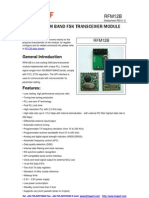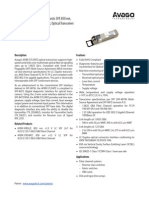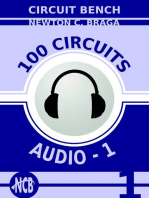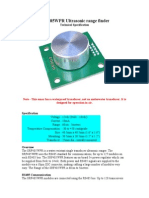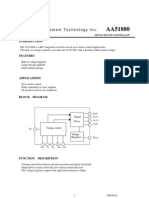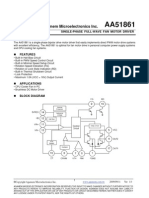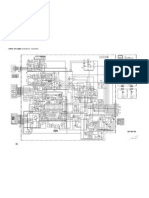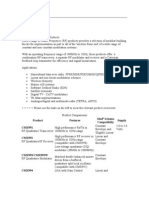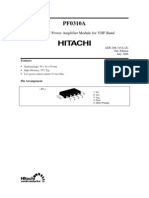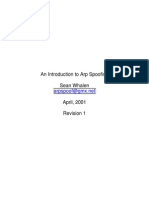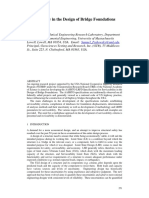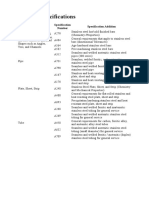Universal ISM Band FSK Receiver RF01: Description
Universal ISM Band FSK Receiver RF01: Description
Uploaded by
MUHAMMAD SISWANTOROCopyright:
Available Formats
Universal ISM Band FSK Receiver RF01: Description
Universal ISM Band FSK Receiver RF01: Description
Uploaded by
MUHAMMAD SISWANTOROOriginal Title
Copyright
Available Formats
Share this document
Did you find this document useful?
Is this content inappropriate?
Copyright:
Available Formats
Universal ISM Band FSK Receiver RF01: Description
Universal ISM Band FSK Receiver RF01: Description
Uploaded by
MUHAMMAD SISWANTOROCopyright:
Available Formats
RF01
Universal ISM Band FSK Receiver RF01
DESCRIPTION:
RF01
Hope’s RF01 is a single chip, low power, multi-channel
FSK receiver designed for use in applications requiring
FCC or ETSI conformance for unlicensed use in the 315,
433, 868, and 915 MHz bands. Used in conjunction with
Hope's FSK transmitters, the RF01 is a flexible, low cost,
and highly integrated solution that does not require
production alignments. All required RF functions are
integrated. Only an external crystal and bypass filtering are
needed for operation.
The RF01 has a completely integrated PLL for easy RF design, and its rapid settling time allows for
fast frequency hopping, bypassing multi-path fading, and interference to achieve robust wireless links.
The PLL’s high resolution allows the usage of multiple channels in any of the bands. The baseband
bandwidth (BW) is programmable to accommodate various deviation, data rate, and crystal tolerance
requirements. The receiver employs the Zero-IF approach with I/Q demodulation, therefore no external
components (except crystal and decoupling) are needed in a typical application. The RF01 is a complete
analog RF and baseband receiver including a multi-band PLL synthesizer with an LNA, I/Q down
converter mixers, baseband filters and amplifiers, and I/Q demodulator.
The chip dramatically reduces the load on the microcontroller with integrated digital data processing:
data filtering, clock recovery, data pattern recognition and integrated FIFO. The automatic frequency
control (AFC) feature allows using a low accuracy (low cost) crystal. To minimize the system cost, the
chip can provide a clock signal for the microcontroller, avoiding the need for two crystals.
For low power applications, the device supports low duty-cycle operation based on the internal
wake-up timer.
BLOCK DIAGRAM
Tel: +86-755-82973805 Fax: +86-755-82973550 E-mail: sales@hoperf.com http://www.hoperf.com
RF01
FEATURES:
z Fully integrated (low BOM, easy design-in)
z No alignment required in production
z Fast settling, programmable, high-resolution PLL
z Fast frequency hopping capability
z High bit rate (up to 115.2 kbps in digital mode and 256 kbps in analog mode)
z Direct differential antenna input
z Programmable baseband bandwidth (67 to 400 kHz)
z Analog and digital RSSI outputs
z Automatic frequency control (AFC)
z Data quality detection (DQD)
z Internal data filtering and clock recovery
z RX pattern recognition
z SPI compatible serial control interface
z Clock and reset signals for microcontroller
z 16 bit RX data FIFO
z Low power duty-cycle mode (less than 0.5 mA average supply current)
z Standard 10 MHz crystal reference
z Wake-up timer
z Low battery detector
z 2.2 to 5.4 V supply voltage
z Low power consumption (~9 mA in low bands)
z Low standby current (0.3 µA)
TYPICAL APPLICATIONS
z Remote control
z Home security and alarm
z Wireless keyboard/mouse and other PC peripherals
z Toy control
z Remote keyless entry
z Tire pressure monitoring
z Telemetry
z Personal/patient data logging
z Remote automatic meter reading
Tel: +86-755-82973805 Fax: +86-755-82973550 E-mail: sales@hoperf.com http://www.hoperf.com
RF01
DETAILED DESCRIPTION
General
The RF01 FSK receiver is the counterpart of the Hope’s FSK transmitter. It covers the unlicensed
frequency bands at 315, 433, 868, and 915 MHz. The device facilitates compliance with FCC and ETSI
requirements.
The programmable PLL synthesizer determines the operating frequency, while preserving accuracy
based on the on-chip crystal-controlled reference oscillator. The PLL’s high resolution allows for the use
of multiple channels in any of the bands.
The receiver employs the Zero-IF approach with I/Q demodulation, allowing the use of a minimal
number of external components in a typical application. The RF01 consists of a fully integrated
multi-band PLL synthesizer, an LNA with switchable gain, I/Q down converter mixers, baseband filters
and amplifiers, and an I/Q demodulator followed by a data filter.
The RF VCO in the PLL performs automatic calibration, which requires only a few microseconds.
Calibration always occurs when the synthesizer begins. If temperature or supply voltage changes
significantly, VCO recalibration can be invoked easily. Recalibration can be initiated at any time by
switching the synthesizer off and back on again.
LNA
The LNA has 250 Ohm input impedance, which works well with the recommended antennas.
If the RF input of the chip is connected to 50 Ohm devices, an external matching circuit is required to
provide the correct matching and to minimize the noise figure of the receiver.
The LNA gain (and linearity) can be selected (0, –6, –14, –20 dB relative to the highest gain)
according to RF signal strength. This is useful in an environment with strong interferers.
Baseband Filters
The receiver bandwidth is selectable
by programming the bandwidth (BW) of the
baseband filters. This allows setting up the
receiver according to the characteristics of
the signal to be received. An appropriate
bandwidth can be selected to
accommodate various FSK deviation, data
rate, and crystal tolerance requirements.
The filter structure is a 7-th order
Butterworth low-pass with 40 dB
suppression at 2*BW frequency. Offset
cancellation is accomplished by using a
high-pass filter with a cut-off frequency
below 7 kHz.
Tel: +86-755-82973805 Fax: +86-755-82973550 E-mail: sales@hoperf.com http://www.hoperf.com
RF01
Data Filtering and Clock Recovery
The output data filtering can be completed by an external capacitor or by using digital filtering
according to the final application.
Analog operation:
The filter is an RC type low-pass filter and a Schmitt-trigger (St). The resistor (10k) and the St is
integrated on the chip. An (external) capacitor can be chosen according to the actual bit-rate. In this
mode the receiver can handle up to 256 kbps data rate.
Digital operation:
The data filter is a digital realization of an analog RC filter followed by a comparator with hysteresis.
In this mode there is a clock recovery circuit (CR), which can provide synchronized clock to the data. With
this clock the received data can fill the RX Data FIFO. The CR has three operation modes: fast, slow, and
automatic. In slow mode, its noise immunity is very high, but it has slower settling time and requires more
accurate data timing than in fast mode. In automatic mode the CR automatically changes between fast
and slow modes. The CR starts in fast mode, then automatically switches to slow mode after locking.
(Only the data filter and the clock recovery use the bit-rate clock. Therefore, in analog mode, there is
no need for setting the correct bit-rate.)
Data Validity Blocks
RSSI
A digital RSSI output is provided to monitor the input signal level. It goes high if the received signal
strength exceeds a given preprogrammed level. An analog RSSI signal is also available. The RSSI
settling time depends on the filter capacitor used.
P1 -65 dBm 1300 mV
P2 -65 dBm 1000 mV
P3 -100 dBm 600 mV
P4 -100 dBm 300 mV
DQD
The Data Quality Detector monitors the I/Q output of the baseband amplifier chain by counting the
consecutive correct 0->1, 1->0 transitions. The DQD output indicates the quality of the signal to be
demodulated. Using this method it is possible to "forecast" the probability of BER degradation. The
programmable DQD parameter defines the threshold for signaling the good/bad data quality by the digital
one-bit DQD output. In cases when the deviation is close to the bit rate, there should be four transitions
during a single one bit period in the I/Q signals. As the bit rate decreases in comparison to the deviation,
more and more transitions will happen during a bit period.
Tel: +86-755-82973805 Fax: +86-755-82973550 E-mail: sales@hoperf.com http://www.hoperf.com
RF01
AFC
By using an integrated Automatic Frequency Control (AFC) feature, the receiver can synchronize its
local oscillator to the received signal, allowing the use of:
z inexpensive, low accuracy crystals
z narrower receiver bandwidth (i.e. increased sensitivity)
z higher data rate
Crystal Oscillator
The chip has a single-pin crystal oscillator circuit, which provides a 10 MHz reference signal for the
PLL. To reduce external parts and simplify design, the crystal load capacitor is internal and
programmable. Guidelines for selecting the appropriate crystal can be found later in this datasheet. The
receiver can supply the clock signal for the microcontroller, so accurate timing is possible without the
need for a second crystal.
When the microcontroller turns the crystal oscillator off by clearing the appropriate bit using the
Configuration Setting Command, the chip provides a fixed number (128) of further clock pulses (“clock
tail”) for the microcontroller to let it go to idle or sleep mode.
Low Battery Voltage Detector
The low battery detector circuit monitors the supply voltage and generates an interrupt if it falls below
a programmable threshold level.
Wake-Up Timer
The wake-up timer has very low current consumption (1.5 µA typical) and can be programmed from
1 ms to several days with an accuracy of ±5%.
It calibrates itself to the crystal oscillator at every startup, and then at every 30 seconds. When the
crystal oscillator is switched off, the calibration circuit switches it back on only long enough for a quick
calibration (a few milliseconds) to facilitate accurate wake-up timing.
Event Handling
In order to minimize current consumption, the receiver supports the sleep mode. Active mode can be
initiated by several wake-up events (wake-up timer timeout, low supply voltage detection, on-chip FIFO
filled up or receiving a request through the serial interface).
If any wake-up event occurs, the wake-up logic generates an interrupt signal which can be used to
wake up the microcontroller, effectively reducing the period the microcontroller has to be active. The
cause of the interrupt can be read out from the receiver by the microcontroller through the SDO pin.
Interface and Controller
An SPI compatible serial interface lets the user select the frequency band, center frequency of the
synthesizer, and the bandwidth of the baseband signal path. Division ratio for the microcontroller clock,
wake-up timer period, and low supply voltage detector threshold are also programmable. Any of these
auxiliary functions can be disabled when not needed. All parameters are set to default after power-on; the
programmed values are retained during sleep mode. The interface supports the read-out of a status
register, providing detailed information about the status of the receiver and the received data. It is also
possible to store the received data bits into the 16bit RX FIFO register and read them out in a buffered
mode. FIFO mode can be enabled through the SPI compatible interface by setting the fe bit to 1 in the
Output and FIFO Mode Command.
Tel: +86-755-82973805 Fax: +86-755-82973550 E-mail: sales@hoperf.com http://www.hoperf.com
RF01
PACKAGE PIN DEFINITIONS
Pin type key: D=digital, A=analog, S=supply, I=input, O=output, IO=input/output
Pin Name Type Function
1 SDI DI Data input of serial control interface
2 SCK DI Clock input of serial control interface
3 nSEL DI Chip select input of three-wire control interface (active low)
FIFO IT (active low) or serial data out for Status Read Command.
4 FFIT/SDODO
Tristate with bushold cell if nSEL=H
5 nIRQ DO Interrupt request output, (active low)
DATA DO Received data output (FIFO not used)
6
nFFS DI FIFO select input
DCLK DO Received data clock output (Digital filter used, FIFO not used)
CFIL AIO External data filter capacitor connection (Analog filter used)
7
FIFO IT (active high) FIFO empty function can be achieved when FIFO IT level is
FFIT DO
set to one
8 CLK DO Clock output for the microcontroller
9 XTL/REF AIO Crystal connection (other terminal of crystal to VSS) / External reference input
10 nRES DO Reset output (active low)
11 VSS_D S Digital VSS(connect to VSS)
12 VSS_A S Analog VSS(connect to VSS)
13 VSS_LNAS LNA VSS(connect to VSS)
14 IN2 AI RF differential signal input
15 IN1 AI RF differential signal input
Tel: +86-755-82973805 Fax: +86-755-82973550 E-mail: sales@hoperf.com http://www.hoperf.com
RF01
16 VDD_LN S Positive supply voltage
17 VDD _A S Analog VDD(connect to VDD)
18 VDD_D S Digital VDD(connect to VDD)
19 ARSSI AO Analog RSSI output
20 VDI DO Valid Data Indicator output
Typical Application
GENERAL DEVICE SPECIFICATION
All voltages are referenced to Vss, the potential on the ground reference pin VSS.
Absolute Maximum Ratings (non-operating)
Symbol Parameter Min Max Units
Vdd Positive supply voltage -0.5 6.0 V
Vin Voltage on any pin -0.5 Vdd+0.5 V
Iin Input current into any pin except VDD and VSS -25 25 mA
ESD Electrostatic discharge with human body model 1000 V
Tst Storage temperature -55 125 ℃
Recommended Operating Range
Symbol Parameter Min Max Units
Vdd Positive supply voltage 2.2 5.4 V
Top Ambient operating temperature -40 85 ℃
Tel: +86-755-82973805 Fax: +86-755-82973550 E-mail: sales@hoperf.com http://www.hoperf.com
RF01
ELECTRICAL SPECIFICATION
(Min/max values are valid over the whole recommended operating range, typ conditions: Top = 27 ℃;
Vdd = 2.7 V)
DC Characteristics
Symbol Parameter Conditions/Notes Min Typ Max Units
315 and 433 MHz bands 9 11
Idd Supply current 868 MHz band 915 MHz 10.5 12.5 mA
band 12 14
Ipd Standby current All blocks disabled 0.3 µA
Low battery voltage
Ilb detector current 0.5 µA
consumption
Wake-up timer current
Iwt 1.5 µA
consumption (Note 1)
Idle current Crystal oscillator and
Ix 3.0 3.5 mA
base-band parts are ON
Low battery detect Programmable in 0.1 V
Vlb 2.2 5.3 V
threshold steps
Low battery detection
Vlba ±3 %
accuracy
Vil Digital input low level 0.3*Vdd V
Vih Digital input high level 0.7*Vdd V
Iil Digital input current Vil = 0 V -1 1 µA
Iih Digital input current Vih = Vdd, Vdd = 5.4 V -1 1 µA
Vol Digital output low level Iol = 2 mA 0.4 V
Voh Digital output high level Ioh = -2 mA Vdd-0.4 V
Note: Using the internal wake-up timer and counter reduces the overall current consumption, which
should permit approximately 6 months operation from a 1500mAh battery.
AC Characteristics
Symbol Parameter Conditions/Notes Min Typ Max Units
315 MHz band, 2.5 kHz resolution 310.24 319.75 MHz
fLO Receiver frequency 433 MHz band, 2.5 kHz resolution 430.24 439.75
868 MHz band, 5.0 kHz resolution 860.48 879.51
915 MHz band, 7.5 kHz resolution 900.72 929.27
mode 0 60 67 75 kHz
mode 1 120 134 150
BW Receiver bandwidth mode 2 180 200 225
mode 3 240 270 300
mode 4 300 350 375
mode 5 360 400 450
BR FSK bit rate With internal digital filters 115.2 kbps
BRA FSK bit rate With analog filter 256 kbps
Pmin Receiver Sensitivity BER 10-3, BW=67 kHz, -109 -100 dBm
BR=1.2 kbps (Note 1)
AFCrange AFC locking range δfFSK: FSK deviation in the 0.8*δfFSK
received signal
IIP3inh Input IP3 In band interferers in high -21 dBm
bands
IIP3outh Input IP3 Out of band interferers -18 dBm
f-fLO > 4MHz
IIP3inl IIP3 (LNA –6 dB gain) In band interferers in low -15 dBm
Tel: +86-755-82973805 Fax: +86-755-82973550 E-mail: sales@hoperf.com http://www.hoperf.com
RF01
bands
IIP3outl IIP3 (LNA –6 dB gain) Out of band interferers -12 dBm
f-fLO > 4MHz
CCR Co-channel rejection BER=10-2 with continuous -7 dB
wave interferer in the channel
ACS Adjacent channel BER=10-2 with continuous 23 dB
selectivity wave interferer in the
adjacent channel, mode 0,
channels at 134 kHz, BR=9.6
kbps, δfFSK=30 kHz
Pmax Maximum input LNA: high gain 0 dBm
power
Rin RF input impedance LNA gain (0, -14 dB) 250 Ohm
real part (differential) LNA gain (-6, -20 dB) 500
(Note 2)
Cin RF input capacitance 1 pF
RSa RSSI accuracy +/-5 dB
RSr RSSI range 46 dB
CARSSI Filter capacitance for 1 nF
ARSSI
RSstep RSSI programmable 6 dB
level steps
RSresp DRSSI response time Until the RSSI output goes 500 µs
high after the input signal
exceeds the pre-programmed
limit. CARRSI=5nF
Note 1: See the BER diagrams in the measurement results section for detailed information.
Note 2: See matching circuit parameters and antenna design guide for information.
AC Characteristics (continued)
Symbol Parameter Conditions/Notes Min Typ Max Units
fref PLL reference frequency (Note 3) 8 10 12 MHz
fres PLL frequency resolution Depends on selected bands 2.5 7.5 kHz
tlock PLL lock time Frequency error < 1kHz after 20 us
10 MHz step
tst, P PLL startup time With running crystal oscillator 250 us
Cxl Crystal load capacitance, see Programmable in 0.5 pF 8.5 16 pF
crystal selection guide steps, tolerance +/-10%
tPOR Internal POR pulse width After Vdd has reached 90% of 50 100 ms
(Note4) final value
tsx Crystal oscillator startup time Crystal ESR < 100 Ohms 5 ms
tPBt Wake-up timer clock period Calibrated every 30 seconds 0.96 1.08 ms
11
twake-up Programmable wake-up time 1 5*10 ms
Cin, D Digital input capacitance 2 pF
tr, f Digital output rise/fall time 15 pF pure capacitive load 10 ns
Note 3: Using other than a 10 MHz crystal is not recommended because the crystal referred timing and
frequency parameters will change accordingly.
Note 4: During this period, commands are not accepted by the chip.
Tel: +86-755-82973805 Fax: +86-755-82973550 E-mail: sales@hoperf.com http://www.hoperf.com
RF01
CONTROL INTERFACE
Commands to the receiver are sent serially. Data bits on pin SDI are shifted into the device upon the
rising edge of the clock on pin SCK whenever the chip select pin nSEL is low. When the nSEL signal is
high, it initializes the serial interface. The number of bits sent is an integer multiple of 8. All commands
consist of a command code, followed by a varying number of parameter or data bits. All data are sent
MSB first (e.g. bit 15 for a 16-bit command). Bits having no influence (don’t care) are indicated with X.
The Power On Reset (POR) circuit sets default values in all control registers.
The receiver will generate an interrupt request (IRQ) for the microcontroller on the following events:
z Supply voltage below the preprogrammed value is detected (LBD)
z Wake-up timer timeout (WK-UP)
z FIFO received the preprogrammed amount of bits (FFIT)
z FIFO overflow (FFOV)
FFIT and FFOV are applicable only when the FIFO is enabled. To find out why the nIRQ was issued, the
status bits should be read out.
Timing Specification
Symbol Parameter Minimum Value [ns]
tCH Clock high time 25
tCL Clock low time 25
tSS Select setup time (nSEL falling edge to SCK rising edge) 10
tSH Select hold time (SCK falling edge to nSEL rising edge) 10
tSHI Select high time 25
tDS Data setup time (SDI transition to SCK rising edge) 5
tDH Data hold time (SCK rising edge to SDI transition) 5
tOD Data delay time 10
Timing Diagram
Tel: +86-755-82973805 Fax: +86-755-82973550 E-mail: sales@hoperf.com http://www.hoperf.com
RF01
Control Commands
Control Word Related Parameters/Functions
Configuration Setting Frequency band, crystal oscillator load capacitance, baseband filter
Command bandwidth, etc.
Frequency Setting Command Set the frequency of the local oscillator
Receiver Setting Command Set VDI source, LNA gain, RSSI threshold,
Wake-up Timer Command Wake-up time period
Low Duty-Cycle Command Enable low duty cycle mode. Set duty-cycle.
Low Battery Detector and
Set LBD voltage and microcontroller clock division ratio
Clock Divider Command
AFC Control Command Set AFC parameters
Data Rate Command Bit rate
Data Filter Command Set data filter type, clock recovery parameters
Output and FIFO Command Set FIFO IT level, FIFO start control, FIFO enable and FIFO fill enable
Note: In the following tables the POR column shows the default values of the command registers after
power on.
Configuration Setting Command
bit 15 14 13 12 11 10 9 8 7 6 5 4 3 2 1 0 POR
1 0 0 b1 b0 eb et ex x3 x2 x1 x0 i2 i1 i0 dc 893Ah
b1 b0 Frequency Band [MHz] Crystal Load
x3 x2 x1 x0
Capacitance [pF]
0 0 315
0 0 0 0 8.5
0 1 433
0 0 0 1 9.0
1 0 868
0 0 1 0 9.5
1 1 915
0 0 1 1 10.0
………….
i2 i1 i0 Baseband Bandwidth [kHz]
1 1 1 0 15.5
0 0 0 reserved
1 1 1 1 16.0
0 0 1 400
0 1 0 340
Bits eb and et control the operation of the low battery
0 1 1 270
detector and wake-up timer, respectively. They are
1 0 0 200
enabled when the corresponding bit is set.
1 0 1 134
If ex is set the crystal is active during sleep mode.
1 1 0 67 When dc bit is set it disables the clock output
1 1 1 reserved
Frequency Setting Command
bit 15 14 13 12 11 10 9 8 7 6 5 4 3 2 1 0 POR
1 0 1 0 f11 f10 f9 f8 f7 f6 f5 f4 f3 f2 f1 f0 A680h
Tel: +86-755-82973805 Fax: +86-755-82973550 E-mail: sales@hoperf.com http://www.hoperf.com
RF01
The 12-bit Frequency Setting Command <f11 : f0> has the The constants C1 and C2 are determined
value F. The value F should be in the range of 96 and 3903. by the selected band as:
When F is out of range, the previous value is kept. The Band [MHz] C1 C2
synthesizer center frequency f can be calculated as: 315 1 31
f0 = 10 MHz * C1 * (C2 + F/4000) 433 1 43
868 2 43
915 3 30
Receiver Setting Command
bit 15 14 13 12 11 10 9 8 7 6 5 4 3 2 1 0 POR
1 1 0 0 0 0 0 0 d1 d0 g1 g0 r2 r1 r0 en C0C1h
Bits 7-6 select the VDI (valid data indicator) signal:
d1 d0 VDI output
0 0 Digital RSSI Out (DRSSI)
0 1 Data Quality Detector Output (DQD)
1 0 Clock recovery lock
1 1 Always
Bits 5-4 LNA gain set:
g1 g0 GLNA (dB relative to max. G)
0 0 0
0 1 -14
1 0 -6
1 1 -20
Bits 3-1 control the threshold of the RSSI detector:
r2 r1 r0 RSSIsetth [dBm]
0 0 0 -103
0 0 1 -97
0 1 0 -91
0 1 1 -85
1 0 0 -79
1 0 1 -73
1 1 0 -67
1 0 1 -61
The RSSI threshold depends on the LNA gain, the real RSSI threshold can be calculated:
RSSIth = RSSIsetth + GLNA
Bit 0 (en) enables the whole receiver chain and crystal oscillator when set. Enable/disable of the wake-up
timer and the low battery detector are not affected by this setting.
Note: Clock tail is not generated when the crystal oscillator is controlled by en bit.
Tel: +86-755-82973805 Fax: +86-755-82973550 E-mail: sales@hoperf.com http://www.hoperf.com
RF01
Wake-Up Timer Command
bit 15 14 13 12 11 10 9 8 7 6 5 4 3 2 1 0 POR
1 1 1 r4 r3 r2 r1 r0 m7 m6 m5 m4 m3 m2 m1 m0 E196h
The wake-up time period can be calculated by M <m7 : m0> and R <r4 : r0>:
T wake-up = M * 2R ms
Low Duty-Cycle Command
bit 15 14 13 12 11 10 9 8 7 6 5 4 3 2 1 0 POR
1 1 0 0 1 1 0 0 d6 d5 d4 d3 d2 d1 d0 en CCOEh
With this command Low Duty-Cycle operation can be set in order to decrease the average power
consumption. The time cycle is determined by the Wake-Up Timer Command.
The Duty-Cycle is calculated by D <d6 : d0> and M. (M is parameter in a Wake-Up Timer Command.)
D.C.= (D * 2 +1) / M *100%
Low Battery Detector and Microcontroller Clock Divider Command
bit 15 14 13 12 11 10 9 8 7 6 5 4 3 2 1 0 POR
1 1 0 0 0 0 1 0 d2 d1 d0 t4 t3 t2 t1 t0 C200h
The 5-bit value T of t4-t0 determines the threshold voltage of the threshold voltage Vlb of the detector:
Vlb= 2.2 V + T * 0.1 V
Clock divider configuration:
d2 d1 d0 Clock Output Frequency [MHz]
0 0 0 1
0 0 1 1.25
0 1 0 1.66
0 1 1 2
1 0 0 2.5
1 0 1 3.33
1 1 0 5
1 1 1 10
AFC Command
bit 15 14 13 12 11 10 9 8 7 6 5 4 3 2 1 0 POR
1 1 0 0 0 1 1 0 a1 a0 rl1 rl0 st fi oe en C6F7h
Bit 0 (en) enables the calculation of the offset frequency by the AFC circuit (it allows the addition of the
content of the output register to the frequency control word of the PLL).
Bit 1 (oe) when set, enables the output (frequency offset) register Bit 2 (fi) when set, switches the circuit to
high accuracy (fine) mode. In this case the processing time is about four times longer, but the measurement
uncertainty is less than half.
Bit 3 (st) strobe edge, when st goes to high, the actual latest calculated frequency error is stored into the
output registers of the AFC block.
Tel: +86-755-82973805 Fax: +86-755-82973550 E-mail: sales@hoperf.com http://www.hoperf.com
RF01
Bit 4-5 (rl0, rl1) range limit: Limits the value of the frequency offset register to the following values:
rl1 rl0 Max dev [fres]
0 0 No restriction fres:
0 1 +15/-16 315, 433MHz bands:2.5kHz
868MHz band: 5kHz
1 0 +7/-8
915MHz band: 7.5kHz
1 1 +3/-4
Bit 6-7 (a0, a1) Automatic operation mode selector:
a1 a0
0 0 Auto mode off (Strobe is controlled by microcontroller)
0 1 Runs only once after each power-up
1 0 Keep the offset only during receiving (VDI=high)
1 1 Keep the offset value independently from the state of the VDI signa
In automatic operation mode (no strobe signal is needed from the microcontroller to update the
output offset register), the AFC circuit is automatically enabled when VDI indicates a potential incoming
signal during the whole measurement cycle and the circuit measures the same result in two subsequent
cycles.
There are three operation modes, example from the possible application:
1, (a1=0, a0=1) The circuit measures the frequency offset only once after power up. This way, the
extended TX/RX maximum distance can be achieved.
Possible application:
In the final application when the user is inserted the battery the circuit measures and compensate
the frequency offset caused by the crystal tolerances. This method enables to use cheaper quartz in the
application and provide quite good protection against locking in an interferer.
2a, (a1=1, a0=0) The circuit measures automatically the frequency offset during an initial low data
rate pattern –easier to receive- (i.e.: 00110011) of the package and change the receiving frequency
according that. The further part of the package can be received by the corrected frequency settings.
2b, (a1=1, a0=0) The transmitter must transmit the first part of the packet with a step higher
deviation and later there is a possibility to reduce it.
Tel: +86-755-82973805 Fax: +86-755-82973550 E-mail: sales@hoperf.com http://www.hoperf.com
RF01
In both cases (2a and 2b) when the VDI indicates poor receiving conditions (VDI goes low) the
output register is automatically cleared. It’s suggested to use when one receiver receives signal from
more than one transmitter.
3, (a1=1, a0=1) It is similar to the 2a and 2b modes, but 3 is suggested to use when a receiver
operates with only one transmitter. After a complete measuring cycle, the measured value is held
independently of the sate of VDI signal.
Data Filter Command
bit 15 14 13 12 11 10 9 8 7 6 5 4 3 2 1 0 POR
1 1 0 0 0 1 0 0 al ml 1 s1 s0 f2 f1 f0 C42Ch
Bit 7 <al>: Clock recovery (CR) auto lock control if set. It means that the CR start in fast mode
after locking it automatically switches to slow mode.
Bit 6 <ml>: Clock recovery lock control 1: fast mode, fast attack and fast release 0: slow mode,
slow attack and slow release Using the slower one requires more accurate bit
timing (see Data Rate Command).
Bit3-4<s0 : s1>: Select the type of the data filter:
s1 s0 Filter Type
0 0 Reserved
0 1 Digital
1 0 Reserved
Digital: this is a digital realization of an analog RC filter followed by a comparator with hysteresis.
The time constant is automatically adjusted to the bit rate defined by the Data Rate Command.
Analog RC filter: the demodulator output is fed to the pin 7 over a 10 kOhm resistor. The filter
characteristic is set by the external capacitor connected to this pin and VSS. (Suggested value for 9600
bps is 3.3 nF)
Bit 0-2 <f0 : f2>: DQD threshold parameter.
Note: To let the DQD report "good signal quality" the threshold parameter should be less than 4 in the
case when the bit-rate is close to the deviation. At higher deviation/bit-rate settings higher threshold
parameter can report "good signal quality" as well.
Data Rate Command
bit 15 14 13 12 11 10 9 8 7 6 5 4 3 2 1 0 POR
1 1 0 0 1 0 0 0 cs r6 r5 r4 r3 r2 r1 r0 C823h
The expected bit rate of the received data stream is determined by the 7-bit value R (bits r6 to r0)
and the 1 bit cs.
BR = 10 MHz / 29 / (R+1) / (1 + cs*7)
In the receiver set R according the next function:
R= (10 MHz / 29 /(1 + cs*7)/ BR) – 1
Apart from setting custom values, the standard bit rates from 600 bps to 115.2 kbps can be
approximated with small error.
Tel: +86-755-82973805 Fax: +86-755-82973550 E-mail: sales@hoperf.com http://www.hoperf.com
RF01
Data rate accuracy requirements:
Clock recovery in slow mode: ∆BR/BR<1/(29*Nbit)
Clock recovery in fast mode: ∆BR/BR<3/(29*Nbit)
BR is the bit rate set in the receiver and ∆BR is bit rate difference between the transmitter and the
receiver. N is the maximal number of bit consecutive ones or zeros in the data stream. It is recommended
for long data packets to include enough 1/0 and 0/1 transitions, and be careful to use the same division
ratio in the receiver and in the transmitter.
∆BR is a theoretical limit for the clock recovery circuit. Clock recovery will not work above this limit.
The clock recovery circuit will always operate below this limit independently from process, temperature,
or Vdd condition.
E.g. Supposing a maximum length of consecutive zeros or ones in the data stream is less than 5 bits,
the necessary relative accuracy is 0.68% in slow mode and 2.1% in fast mode.
Output and FIFO Mode Command
bit 15 14 13 12 11 10 9 8 7 6 5 4 3 2 1 0 POR
1 1 0 0 1 1 1 0 f3 f2 f1 f0 s1 s0 ff fe CE85h
Bit 4-7 <f3:f0>: FIFO IT level. The FIFO generates IT when number of the received data bits reaches this
level.
Bit 2-3 <s1:s0>: Set the input of the FIFO fill start condition:
s1 s0
0 0 VDI
0 1 Sync. Word
1 0 reserved
1 1 Always
Note: VDI (Valid Data Indicator) see further details in Receiver Control Word.
Bit 1: <ff> Enables FIFO fill after synchron word reception. FIFO fill stops when this bit is cleared.
Bit 0: <fe> Enables the 16bit deep FIFO mode. To clear the FIFO’s counter and content, it has to be
set zero.
Note: To restart the synchron word reception bit 1 should be cleared and set.This action will initialize the
Tel: +86-755-82973805 Fax: +86-755-82973550 E-mail: sales@hoperf.com http://www.hoperf.com
RF01
FIFO and clear its content. Bit 0 modifies the function of pin 6 and pin 7. Pin 6 (nFFS) will become input if fe
is set to 1. If the chip is used in FIFO mode, do not allow this to be a floating input.
Reset Mode Command
bit 15 14 13 12 11 10 9 8 7 6 5 4 3 2 1 0 POR
1 1 0 1 1 0 1 0 0 0 0 0 0 0 0 dr DAOOh
Bit 0 (dr): Disables the highly sensitive RESET mode. If this bit is cleared, a 600 mV glitch in the power supply
may cause a system reset. For
more detailed description see the Reset modes section.
Status Read Command:
The read command starts with a zero, whereas all other control commands start with a one.
Therefore, after receiving the first bit of the control command the RF01 identifies it as a read command.
So as the first bit of the command is received, the receiver starts to clock out the status bits on the SDO
output as follows:
Status Register Read Sequence with FIFO Read Example
It is possible to read out the content of the FIFO after the reading of the status bits. The command can be
aborted after any read bits by rising edge of the select signal.
Note: The FIFO IT bit behaves like a status bit, but generates nIRQ pulse if active. To check whether there
is a sufficient amount of data in the FIFO, the SDO output can be tested. In extreme speed critical
applications, it can be useful to read only the first four bits (FIFO IT -LBD) to clear the FFOV, WK-UP, and
LBD bits. During the FIFO access the fSCK cannot be higher than fref /4, where fref is the crystal oscillator
frequency. If the FIFO is read in this mode the nFFS input must be connected to logic high level.
Definitions of the bits in the above timing diagram:
FIFO IT Number of the data bits in the FIFO is reached the preprogrammed limit
FFOV FIFO overflow
WK-UP Wake-up timer overflow
LBD Low battery detect, the power supply voltage is below the preprogrammed limit
FFEM FIFO is empty
DRSSI The strength of the incoming signal is above the preprogrammed limit
DQD Data Quality Detector detected a good quality signal
Tel: +86-755-82973805 Fax: +86-755-82973550 E-mail: sales@hoperf.com http://www.hoperf.com
RF01
CRL Clock recovery lock
ATGL Toggling in each AFC cycle
ASAME AFC stablized (measured twice the same offset value)
OFFS6, 4-0 Offset value to be add to the value of the Frequency control word
FIFO Buffered Data Read
In this operating mode, incoming data are clocked into a 16 bit FIFO buffer. The receiver starts to fill
up the FIFO when the Valid Data Indicator (VDI) bit and/or the synchron word recognition circuit indicates
potentially real incoming data. This prevents the FIFO from being filled with noise and overloading the
external microcontroller.
For further details see the Receiver Setting Command and the Output and FIFO Command.
Polling Mode:
The nFFS signal selects the buffer directly and its content could be clocked out through pin SDO by
SCK. Set the FIFO IT level to 1. In this case, as long as FFIT indicates received bits in the FIFO, the
controller may continue to take the bits away. When FFIT goes low, no more bits need to be taken. An
SPI read command is also available.
Interrupt Controlled Mode:
The user can define the FIFO level (the number of received bits) which will generate the nFFIT when
exceeded. The status bits report the changed FIFO status in this case.
FIFO Read Example with FFIT Polling:
During FIFO access the fSCK cannot be higher than fref /4, where fref is the crystal oscillator frequency.
RX-TX ALIGNMENT PROCEDURES
RX-TX frequency offset can be caused only by the differences in the actual reference frequency. To
Tel: +86-755-82973805 Fax: +86-755-82973550 E-mail: sales@hoperf.com http://www.hoperf.com
RF01
minimize these errors it is suggested to use the same crystal type and the same PCB layout for the
crystal placement on the RX and TX PCBs.
To verify the possible RX-TX offset it is suggested to measure the CLK output of both chips with a
high level of accuracy. Do not measure the output at the XTL pin since the measurement process itself
will change the reference frequency. Since the carrier frequencies are derived from the reference
frequency, having identical reference frequencies and nominal frequency settings at the TX and RX side
there should be no offset if the CLK signals have identical frequencies.
It is possible to monitor the actual RX-TX offset using the AFC status report included in the status
byte of the receiver. By reading out the status byte from the receiver the actual measured offset
frequency will be reported. In order to get accurate values the AFC has to be disabled during the read by
clearing the "en" bit in the AFC Control Command (bit 0).
Power-on reset
After power up the supply voltage starts to rise from 0V. The reset block has an internal ramping voltage
reference (reset-ramp signal), which is rising at 100mV/ms (typical) rate. The chip remains in reset state while
the voltage difference between the actual Vdd and the internal reset-ramp signal is higher than the reset
threshold voltage, which is 600 mV (typical). As long as the Vdd voltage is less than 1.6V (typical)
the chip stays in reset mode regardless the voltage difference between the Vdd and the internal ramp signal.
The reset event can last up to 150ms supposing that the Vdd reaches 90% its final value within 1ms. During this
period the chip does not accept control commands via the serial control interface.
Power-on reset example:
Power glitch reset
The internal reset block has two basic mode of operation: normal and sensitive reset. The default mode is
sensitive, which can be changed by the appropriate control command (see Related control commands at the
end of this section). In normal mode the power glitch detection circuit is disabled.
There can be spikes or glitches on the Vdd line if the supply filtering is not satisfactory or the internal resistance
of the power supply is too high. In such cases if the sensitive reset is enabled an (unwanted) reset will be
generated if the positive going edge of the Vdd has a rising rate greater than 100mV/ms and the voltage
difference between the internal ramp signal and the Vdd reaches the reset threshold voltage (600 mV). Typical
case when the battery is weak and due to its increased internal resistance a sudden decrease of the current
consumption (for example turning off the power amplifier) might lead to an increase in supply voltage. If for
some reason the sensitive reset cannot be disabled step-by-step decrease of the current consumption (by
turning off the different stages one by one) can help to avoid this problem.
Tel: +86-755-82973805 Fax: +86-755-82973550 E-mail: sales@hoperf.com http://www.hoperf.com
RF01
Any negative change in the supply voltage will not cause reset event unless the Vdd level reaches the reset
threshold voltage (250mV in normal mode, 1.6V in sensitive reset mode).
If the sensitive mode is disabled and the power supply turned off the Vdd must drop below 250mV in order to
trigger a power-on reset event when the supply voltage is turned back on. If the decoupling capacitors keep
their charges for a long time it could happen that no reset will be generated upon power-up because the power
glitch detector circuit is disabled.
Note that the reset event reinitializes the internal registers, so the sensitive mode will be enabled again.
Sensitive Reset Enabled, Ripple on Vdd:
Sensitive reset disabled:
Software reset
Software reset can be issued by sending the appropriate control command (described at the end of the section)
to the chip. The result of the command is the same as if power-on reset was occurred. When the nRES pin
connected to the reset pin of the microcontroller, using the software reset command may cause unexpected
problems.
Vdd line filtering
During the reset event (caused by power-on, fast positive spike on the supply line or software reset command)
it is very important to keep the Vdd line as smooth as possible. Noise or periodic disturbing signal superimposed
the supply voltage may prevent the part getting out from reset state. To avoid this phenomenon use adequate
filtering on the power supply line to keep the level of the disturbing signal below 10mVp-p in the DC – 50kHz
range for 200ms from Vdd ramp start.. Typical example when a switch-mode regulator is used to supply the
Tel: +86-755-82973805 Fax: +86-755-82973550 E-mail: sales@hoperf.com http://www.hoperf.com
RF01
radio, switching noise may be present on the Vdd line. Follow the manufacturer’s recommendations how to
decrease the ripple of the regulator IC and/or how to shift the switching frequency.
Related control commands
“Reset Mode Command”
Setting bit<0> to high will change the reset mode to normal from the default sensitive.
“SW Reset Command”
Issuing FF00h command will trigger software reset. See the Wake-up Timer Command.
CRYSTAL SELECTION GUIDELINES
The crystal oscillator of the RF01 requires a 10 MHz parallel mode crystal. The circuit contains an
integrated load capacitor in order to minimize the external component count. The internal load
capacitance value is programmable from 8.5 pF to 16 pF in 0.5 pF steps. With appropriate PCB layout,
the total load capacitance value can be 10 pF to 20 pF so a variety of crystal types can be used.
When the total load capacitance is not more than 20 pF and a worst case 7 pF shunt capacitance (C0)
value is expected for the crystal, the oscillator is able to start up with any crystal having less than 300
ohms ESR (equivalent series loss resistance). However, lower C0 and ESR values guarantee faster
oscillator startup.
The crystal frequency is used as the reference of the PLL, which generates the local oscillator
frequency (fLO). Therefore fLO is directly proportional to the crystal frequency. The accuracy requirements
for production tolerance, temperature drift and aging can thus be determined from the maximum
allowable local oscillator frequency error.
Maximum XTAL Tolerances Including Temperature and Aging [ppm]
Whenever a low frequency error is essential for the application, it is possible to “pull” the crystal to
Tel: +86-755-82973805 Fax: +86-755-82973550 E-mail: sales@hoperf.com http://www.hoperf.com
RF01
the accurate frequency by changing the load capacitor value. The widest pulling range can be achieved if
the nominal required load capacitance of the crystal is in the “midrange”, for example 16 pF. The
“pull-ability” of the crystal is defined by its motional capacitance and C0.
The on chip AFC is capable to correct TX/RX carrier offsets as much as 80% of the deviation of the
received FSK modulated signal.
Note: There may be other requirements for the TX carrier accuracy with regards to the requirements as
defined by standards and/or channel separations.
MEASUREMENT RESULTS
BER Measurement Results
Frequency Offset Effected Sensitivity Degradation
Tel: +86-755-82973805 Fax: +86-755-82973550 E-mail: sales@hoperf.com http://www.hoperf.com
RF01
Input impedance
Measured input return loss on the demo boards with suggested matching circuit
Tel: +86-755-82973805 Fax: +86-755-82973550 E-mail: sales@hoperf.com http://www.hoperf.com
RF01
REFERENCE DESIGNS
Schematic
PCB layout
Top view
Bottom view
Tel: +86-755-82973805 Fax: +86-755-82973550 E-mail: sales@hoperf.com http://www.hoperf.com
RF01
RF01 BONDING DIAGRAM
Pad Opening: 85 um square, except 76 um octagon pads (AN1, AN2)
Die Size: 2700 X 3315 um
Tel: +86-755-82973805 Fax: +86-755-82973550 E-mail: sales@hoperf.com http://www.hoperf.com
RF01
This document may contain preliminary information and is subject to
change by Hope Microelectronics without notice. Hope Microelectronics
assumes no responsibility or liability for any use of the information
contained herein. Nothing in this document shall operate as an express
HOPE MICROELECTRONICS CO.,LTD or implied license or indemnity under the intellectual property rights of
Add:4/F, Block B3, East Industrial Area, Hope Microelectronics or third parties. The products described in this
Huaqiaocheng, Shenzhen, Guangdong, document are not intended for use in implantation or other direct life
China support applications where malfunction may result in the direct physical
Tel: 86-755-82973805 harm or injury to persons. NO WARRANTIES OF ANY KIND,
Fax: 86-755-82973550 INCLUDING, BUT NOT LIMITED TO, THE IMPLIED WARRANTIES OF
Email: sales@hoperf.com MECHANTABILITY OR FITNESS FOR A ARTICULAR PURPOSE, ARE
Website: http://www.hoperf.com OFFERED IN THIS DOCUMENT.
http://www.hoperf.cn
http://hoperf.en.alibaba.com ©2006, HOPE MICROELECTRONICS CO.,LTD. All rights reserved.
Tel: +86-755-82973805 Fax: +86-755-82973550 E-mail: sales@hoperf.com http://www.hoperf.com
You might also like
- Turbine Steam Inlet SystemDocument14 pagesTurbine Steam Inlet SystemDr-Amit Kumar SinghNo ratings yet
- S171E P3 Modbus Protocol Manual V1 0A 04 2007Document96 pagesS171E P3 Modbus Protocol Manual V1 0A 04 2007Anurag ChopraNo ratings yet
- Diesel Generator TroubleshootingDocument7 pagesDiesel Generator TroubleshootingChandra Vinoth Senthilnathan100% (4)
- CC 1101Document103 pagesCC 1101Sói Ăn RauNo ratings yet
- RFM12BDocument12 pagesRFM12BjkhgljksdflhgkjfdshkNo ratings yet
- CC 1101Document103 pagesCC 1101jeronimoschmitzNo ratings yet
- SG8 RF Signal Generator Data SheetDocument5 pagesSG8 RF Signal Generator Data SheetJayram VeliyathNo ratings yet
- RXM XXX ES Data GuideDocument11 pagesRXM XXX ES Data GuideAstrid PorticaNo ratings yet
- RFM12BDocument10 pagesRFM12BLeonardo Gonzales JaraNo ratings yet
- RF02 Universal ISM Band FSK Transmitter: DescriptionDocument24 pagesRF02 Universal ISM Band FSK Transmitter: DescriptionMUHAMMAD SISWANTORONo ratings yet
- Low Power Sub-1 GHZ RF TransmitterDocument61 pagesLow Power Sub-1 GHZ RF Transmitterkamesh_patchipala9458No ratings yet
- Low-Power Sub-1 GHZ RF Transceiver: ApplicationsDocument105 pagesLow-Power Sub-1 GHZ RF Transceiver: Applicationsmassimo_pirazziniNo ratings yet
- Sunrom - 433MHz - STT-433Document3 pagesSunrom - 433MHz - STT-433help-me-quickNo ratings yet
- RFM01Document7 pagesRFM01D Arum KurniasNo ratings yet
- ICOM IC-7410 BrochureDocument3 pagesICOM IC-7410 Brochuregus289No ratings yet
- Circuit Diagram of RC Transmitter and ReceiverDocument6 pagesCircuit Diagram of RC Transmitter and ReceivernicoletabytaxNo ratings yet
- 13.56Mhz Rfid Transceiver: (1) Ratp / Innovatron TechnologyDocument25 pages13.56Mhz Rfid Transceiver: (1) Ratp / Innovatron TechnologyorlandomaskNo ratings yet
- The RC Link and ASK Environment: RF Based Wireless Remote Control SystemDocument9 pagesThe RC Link and ASK Environment: RF Based Wireless Remote Control SystemKhang VanNo ratings yet
- Sunair RT-9000B DatasheetDocument2 pagesSunair RT-9000B Datasheetfalcom2No ratings yet
- Syn470R Datasheet: (300-450Mhz Ask Receiver)Document21 pagesSyn470R Datasheet: (300-450Mhz Ask Receiver)mariachi1980No ratings yet
- Data Sheet: 1 General Description 2 Key FeaturesDocument47 pagesData Sheet: 1 General Description 2 Key FeaturesGiorgi IoanaNo ratings yet
- AV02 2565EN DS AFBR 703SMZ - 28jan20130Document19 pagesAV02 2565EN DS AFBR 703SMZ - 28jan20130Mauj SatsangiNo ratings yet
- SU66AA FTLF1323P1xTR SpecRevADocument11 pagesSU66AA FTLF1323P1xTR SpecRevAKCVNo ratings yet
- Analog Devices Datasheet CN0511Document9 pagesAnalog Devices Datasheet CN0511Ravindra MogheNo ratings yet
- Radio Frequency Over Optical FiberDocument31 pagesRadio Frequency Over Optical Fibersiva kumar mandhatiNo ratings yet
- MICRF230Document20 pagesMICRF230Amador Garcia IIINo ratings yet
- Design and Analysis of A Low Power Passive UHF RFID Transponder ICDocument6 pagesDesign and Analysis of A Low Power Passive UHF RFID Transponder ICAli ErenNo ratings yet
- Telephone Based TV Sound ControllerDocument25 pagesTelephone Based TV Sound ControllerChinmayi GupthaNo ratings yet
- Data Sheet: AFBR-57L5APZDocument19 pagesData Sheet: AFBR-57L5APZfgdllkjlklkNo ratings yet
- SAA1054Document14 pagesSAA1054partho mondolNo ratings yet
- 40G QSFP+ PSM IR4 SOQP-3140-01 From SinovoDocument16 pages40G QSFP+ PSM IR4 SOQP-3140-01 From SinovomelissaNo ratings yet
- ATB PH32 LCDE DatasheetDocument11 pagesATB PH32 LCDE DatasheettommyNo ratings yet
- 2-Com115 FSK PDFDocument9 pages2-Com115 FSK PDFChauthanh94No ratings yet
- Ad 9361Document4 pagesAd 9361zampradeepNo ratings yet
- Avago AFCT 739ASMZ DatasheetDocument18 pagesAvago AFCT 739ASMZ DatasheetTran Hoang TungNo ratings yet
- Si4012 ShortDocument2 pagesSi4012 ShortIanNo ratings yet
- cc1120 Radio Transciever DatasheetDocument37 pagescc1120 Radio Transciever Datasheeth1238709mNo ratings yet
- Satellite ModemDocument2 pagesSatellite ModemalifshahNo ratings yet
- Uhf Ask Receiver IC U3741BM: FeaturesDocument33 pagesUhf Ask Receiver IC U3741BM: FeaturesBegu CataNo ratings yet
- RFCard 2005 ADocument2 pagesRFCard 2005 ASughra2305No ratings yet
- LimeMicro Whitepaper2 PDFDocument7 pagesLimeMicro Whitepaper2 PDFThevesteNo ratings yet
- BlueOptics BO66HXX640D - 2-4-8GBASE-CWDM - XFP - Transceiver - 1471nm - 1611nm - 40KM - Singlemode - LC - Duplex - 10 - GigabitDocument8 pagesBlueOptics BO66HXX640D - 2-4-8GBASE-CWDM - XFP - Transceiver - 1471nm - 1611nm - 40KM - Singlemode - LC - Duplex - 10 - GigabitCBO GmbHNo ratings yet
- Datum PSM 500LT Satellite TerminalDocument2 pagesDatum PSM 500LT Satellite TerminalrazfanmnNo ratings yet
- Terrasat C-Band IBUCDocument2 pagesTerrasat C-Band IBUCEng Simon Peter NsoziNo ratings yet
- Pin Configuration of Three Legs Variable CapacitorDocument14 pagesPin Configuration of Three Legs Variable CapacitorFernandoNo ratings yet
- Abhishek Mitra and Nerdev Sharma IIIT Allahabad Fifth Semester Mini ProjectDocument19 pagesAbhishek Mitra and Nerdev Sharma IIIT Allahabad Fifth Semester Mini Projectchart328No ratings yet
- U3741BMDocument32 pagesU3741BMOlga PlohotnichenkoNo ratings yet
- Data Sheet: Radio Tuning PLL Frequency SynthesizerDocument13 pagesData Sheet: Radio Tuning PLL Frequency SynthesizerElchat InternacionalNo ratings yet
- Block-Diagram Tour Late Model (5100 Series) EF Johnson 700/800 MHZ 2-Way Radio RF DeckDocument7 pagesBlock-Diagram Tour Late Model (5100 Series) EF Johnson 700/800 MHZ 2-Way Radio RF DeckJimNo ratings yet
- EXC - RTX18B - 2-25, Data Sheet en Rev 2 - 3Document2 pagesEXC - RTX18B - 2-25, Data Sheet en Rev 2 - 3William RamirezNo ratings yet
- Wireless Microphone System: Live Sound Conference Seminar School Church / House of WorshipDocument6 pagesWireless Microphone System: Live Sound Conference Seminar School Church / House of WorshipCarlos ArdilaNo ratings yet
- ASK 433MHzDocument3 pagesASK 433MHzGeo BabuNo ratings yet
- K2BLADocument7 pagesK2BLAlm386100% (1)
- CC 1200Document35 pagesCC 1200César TapiaNo ratings yet
- TX2RX2 0202Document15 pagesTX2RX2 0202claudinei_verissimo8529No ratings yet
- 900 MHZ Digital Spread Spectrum Transceiver: FeaturesDocument13 pages900 MHZ Digital Spread Spectrum Transceiver: FeaturesmgferreyraNo ratings yet
- C) Descripción GSM SonyDocument4 pagesC) Descripción GSM SonyMiguel Angel Roman UrrietaNo ratings yet
- Data Sheet - Preliminary: Afbr-79Eiz, Afbr-79EidzDocument19 pagesData Sheet - Preliminary: Afbr-79Eiz, Afbr-79EidzlksmrNo ratings yet
- Reference Guide To Useful Electronic Circuits And Circuit Design Techniques - Part 2From EverandReference Guide To Useful Electronic Circuits And Circuit Design Techniques - Part 2No ratings yet
- Srf485wpr Ultrasonic Range FinderDocument7 pagesSrf485wpr Ultrasonic Range FinderMUHAMMAD SISWANTORONo ratings yet
- A A 51880Document5 pagesA A 51880MUHAMMAD SISWANTORONo ratings yet
- STK4221IIDocument6 pagesSTK4221IIMUHAMMAD SISWANTORONo ratings yet
- Agamem Microelectronics Inc.: Preliminary Single-Phase Full-Wave Fan Motor DriverDocument1 pageAgamem Microelectronics Inc.: Preliminary Single-Phase Full-Wave Fan Motor DriverMUHAMMAD SISWANTORONo ratings yet
- PR12 4DNDocument1 pagePR12 4DNMUHAMMAD SISWANTORONo ratings yet
- YF-S201 Hall Effect Water Flow Counter Sensor - BlackDocument3 pagesYF-S201 Hall Effect Water Flow Counter Sensor - BlackMUHAMMAD SISWANTORONo ratings yet
- Ds 4500reader20090513Document2 pagesDs 4500reader20090513Sudhish AggarwalNo ratings yet
- Jbl-GT5A402 CarampDocument15 pagesJbl-GT5A402 CarampMUHAMMAD SISWANTORO0% (1)
- BTX 250Document17 pagesBTX 250MUHAMMAD SISWANTORONo ratings yet
- JBL E150P Service ManualDocument28 pagesJBL E150P Service ManualMUHAMMAD SISWANTORO100% (4)
- Aiwa HVFX4100Document71 pagesAiwa HVFX4100MUHAMMAD SISWANTORONo ratings yet
- ADC-FM106: Simple ManualDocument3 pagesADC-FM106: Simple ManualMUHAMMAD SISWANTORONo ratings yet
- BTX 250Document17 pagesBTX 250MUHAMMAD SISWANTORONo ratings yet
- RF02 Universal ISM Band FSK Transmitter: DescriptionDocument24 pagesRF02 Universal ISM Band FSK Transmitter: DescriptionMUHAMMAD SISWANTORONo ratings yet
- Aiwa LM 99Document1 pageAiwa LM 99MUHAMMAD SISWANTORONo ratings yet
- S-AV10L, S-AV10H: VHF RF Power Amplifier ModuleDocument4 pagesS-AV10L, S-AV10H: VHF RF Power Amplifier ModuleMUHAMMAD SISWANTORONo ratings yet
- Product Features Mod Scheme Compatibilty Supply CMX991Document4 pagesProduct Features Mod Scheme Compatibilty Supply CMX991MUHAMMAD SISWANTORONo ratings yet
- MOS FET Power Amplifier Module For VHF Band: FeaturesDocument10 pagesMOS FET Power Amplifier Module For VHF Band: FeaturesMUHAMMAD SISWANTORONo ratings yet
- CDP-TX/RX-02N: UHF Narrow Band Radio Data ModuleDocument25 pagesCDP-TX/RX-02N: UHF Narrow Band Radio Data ModuleMUHAMMAD SISWANTORONo ratings yet
- RF01 Programming Guide: 1 Brief DescriptionDocument18 pagesRF01 Programming Guide: 1 Brief DescriptionMUHAMMAD SISWANTORONo ratings yet
- 805 RF434.42M BDocument2 pages805 RF434.42M BMUHAMMAD SISWANTORONo ratings yet
- Monolithic Crystal Filter MQF10.7-0240/04: Potsdamer Str. 18 D-14513 TeltowDocument1 pageMonolithic Crystal Filter MQF10.7-0240/04: Potsdamer Str. 18 D-14513 TeltowMUHAMMAD SISWANTORONo ratings yet
- Holy Stone Enterprise Co., LTD: MO-TX4915-FDocument4 pagesHoly Stone Enterprise Co., LTD: MO-TX4915-FMUHAMMAD SISWANTORONo ratings yet
- Ghasemi and BasuDocument11 pagesGhasemi and BasuPreethiNo ratings yet
- Examination Report - SH DamDocument59 pagesExamination Report - SH DamsarvannnNo ratings yet
- Image DenoisingDocument54 pagesImage DenoisingShivkant ThakurNo ratings yet
- An Introduction To Arp Spoofing Sean WhalenDocument7 pagesAn Introduction To Arp Spoofing Sean Whalenlsdn1No ratings yet
- LG Monitor L1730BBUHM - Chassis CL-62Document32 pagesLG Monitor L1730BBUHM - Chassis CL-62tavi100% (1)
- Datastage AnswersDocument3 pagesDatastage AnswersAnonymousHPNo ratings yet
- Bomba de LubricaciónDocument4 pagesBomba de LubricaciónJohan MezaNo ratings yet
- Serviceability in The Design of Bridge FoundationsDocument11 pagesServiceability in The Design of Bridge FoundationsAnton Husen PurboyoNo ratings yet
- Piaggio Liberty 125 - 150 4T I.E. Vietnam MY 2010 (EN)Document275 pagesPiaggio Liberty 125 - 150 4T I.E. Vietnam MY 2010 (EN)Manualles80% (10)
- #006.03 Concrete Accessories (Anchoring Resin)Document5 pages#006.03 Concrete Accessories (Anchoring Resin)M. Murat ErginNo ratings yet
- 1.2 Beams With Uniform Load and End Moments: CHAPTER 1: Analysis of BeamsDocument8 pages1.2 Beams With Uniform Load and End Moments: CHAPTER 1: Analysis of Beamsfabricio88No ratings yet
- VesdaDocument6 pagesVesdaBen LimNo ratings yet
- Magister Operandi Autumn Edition 2019Document46 pagesMagister Operandi Autumn Edition 2019Sagar ShahNo ratings yet
- Amichi - CatalogueDocument4 pagesAmichi - CatalogueZoran SimanicNo ratings yet
- KK-IGMH-M-2005-ACMV - OT SCH - Ra - 08.11.17Document1 pageKK-IGMH-M-2005-ACMV - OT SCH - Ra - 08.11.17Teo Pei SanNo ratings yet
- Perkins 2306C E14TAG2Document2 pagesPerkins 2306C E14TAG2JONATHAN100% (1)
- Lucas TVS Price List 2nd May 2011Document188 pagesLucas TVS Price List 2nd May 2011acere18No ratings yet
- 6493 1002 9838 3350 (BULK ORDERS) Tiny - CC/DCT - FB @dynacore: 81330458 (WhatsappDocument10 pages6493 1002 9838 3350 (BULK ORDERS) Tiny - CC/DCT - FB @dynacore: 81330458 (WhatsappChee JianzhiNo ratings yet
- LANWA Product Portfolio Final-LoresDocument20 pagesLANWA Product Portfolio Final-Loreschanna hettiarachchiNo ratings yet
- TransposonDocument3 pagesTransposonArafa JebinNo ratings yet
- Kia7042ap PDFDocument4 pagesKia7042ap PDFGoguredNo ratings yet
- Ponnam Sriram 21401064337 Ponnam Chandraiah: Tsecet - 2020 Telangana State Council of Higher EducationDocument2 pagesPonnam Sriram 21401064337 Ponnam Chandraiah: Tsecet - 2020 Telangana State Council of Higher EducationHappy HourNo ratings yet
- Shop Assembly Tank JDocument5 pagesShop Assembly Tank JSyed JafarNo ratings yet
- Cellular GlassDocument2 pagesCellular GlassPaolo NgNo ratings yet
- Cryptology: Plaintext - Is The Message Before It Was CodedDocument3 pagesCryptology: Plaintext - Is The Message Before It Was CodedKyla Marie PlazaNo ratings yet
- Kalibrasi Alat OkDocument8 pagesKalibrasi Alat OkNovita PutriNo ratings yet
- General Specifications For SS PIPES & TUBESDocument10 pagesGeneral Specifications For SS PIPES & TUBESDIBYENDU MONDALNo ratings yet








